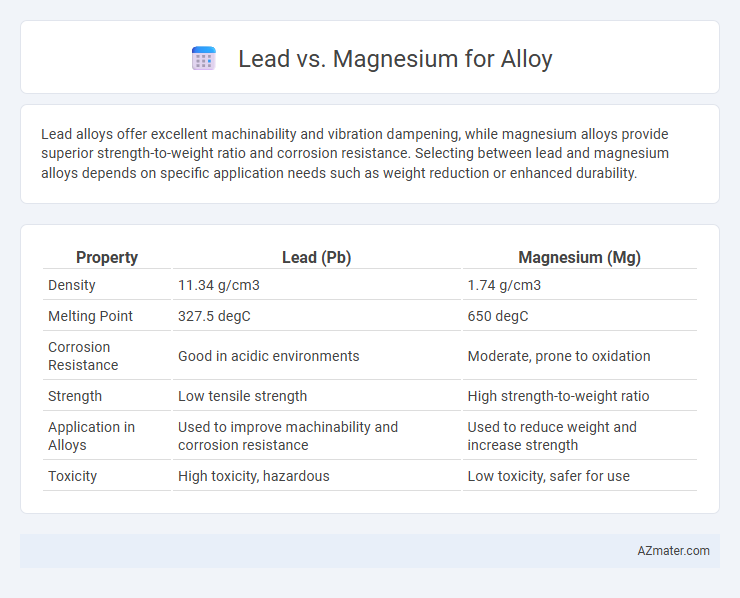Lead alloys offer excellent machinability and vibration dampening, while magnesium alloys provide superior strength-to-weight ratio and corrosion resistance. Selecting between lead and magnesium alloys depends on specific application needs such as weight reduction or enhanced durability.
Table of Comparison
| Property | Lead (Pb) | Magnesium (Mg) |
|---|---|---|
| Density | 11.34 g/cm3 | 1.74 g/cm3 |
| Melting Point | 327.5 degC | 650 degC |
| Corrosion Resistance | Good in acidic environments | Moderate, prone to oxidation |
| Strength | Low tensile strength | High strength-to-weight ratio |
| Application in Alloys | Used to improve machinability and corrosion resistance | Used to reduce weight and increase strength |
| Toxicity | High toxicity, hazardous | Low toxicity, safer for use |
Introduction to Alloying Elements
Lead and magnesium serve distinct roles as alloying elements, with lead primarily enhancing machinability in metals like brass and steel, while magnesium significantly improves strength-to-weight ratio and corrosion resistance in aluminum alloys. Lead's low melting point and ductility facilitate chip breaking in cutting applications, whereas magnesium's low density and high strength make it ideal for aerospace and automotive components. Understanding the specific contributions of these elements allows metallurgists to tailor alloys for performance, durability, and manufacturing efficiency.
Overview of Lead and Magnesium in Alloys
Lead and magnesium serve distinct roles in alloy applications due to their differing properties and benefits. Lead is commonly used in alloys to improve machinability and corrosion resistance, particularly in bearings and solders, while magnesium alloys are prized for their light weight and high strength-to-weight ratio, making them ideal for aerospace and automotive components. The choice between lead and magnesium alloys depends on factors such as weight reduction requirements, mechanical performance, and environmental considerations, with magnesium offering eco-friendlier alternatives to lead-based materials.
Physical Properties Comparison
Lead alloys exhibit high density and excellent corrosion resistance, making them suitable for applications requiring weight and chemical stability. Magnesium alloys are significantly lighter, with densities around 1.74 g/cm3 compared to lead's 11.34 g/cm3, offering superior strength-to-weight ratios and enhanced machinability. Magnesium also provides better thermal conductivity and impact resistance, making it ideal for aerospace and automotive components.
Mechanical Strength and Durability
Magnesium alloys offer superior mechanical strength-to-weight ratios compared to lead alloys, making them ideal for applications where lightweight and durability are critical. Lead alloys, while possessing high density and corrosion resistance, generally exhibit lower tensile strength and fatigue resistance, limiting their use in structural components. Magnesium's enhanced mechanical durability under stress cycles ensures longer lifespan in aerospace and automotive parts compared to lead-based materials.
Corrosion Resistance Differences
Lead-infused alloys demonstrate enhanced corrosion resistance in acidic and chloride-rich environments due to lead's ability to form a protective layer that slows down metal degradation. Magnesium alloys, while lightweight and strong, typically exhibit higher susceptibility to corrosion, especially in marine or saltwater conditions, requiring protective coatings or alloying with other elements to improve durability. The selection between lead and magnesium alloys depends largely on the specific environmental exposure and intended application, with lead offering superior resistance in hostile chemical settings.
Weight and Density Considerations
Magnesium alloys offer significantly lower density, approximately 1.74 g/cm3, compared to lead's density of 11.34 g/cm3, making them ideal for lightweight applications in automotive and aerospace industries. The substantially lighter weight of magnesium-based alloys enhances fuel efficiency and performance due to reduced vehicle mass. Lead alloys, while denser and heavier, provide superior radiation shielding and vibration dampening, but their weight limits their use where minimal mass is critical.
Environmental and Health Impacts
Magnesium alloys exhibit significantly lower toxicity and environmental hazards compared to lead alloys, given lead's classification as a toxic heavy metal with bioaccumulative properties that pose risks to soil, water, and human health. Magnesium, being biodegradable and essential for the human body, presents fewer ecological concerns during extraction, processing, and disposal phases, making it a safer choice in automotive and aerospace applications. Regulatory restrictions on lead usage due to its neurotoxic effects propel the industry toward magnesium alloys, which offer comparable mechanical properties without the severe health and environmental liabilities.
Industrial Applications of Lead Alloys
Lead alloys find extensive use in industrial applications due to their excellent corrosion resistance, high density, and superior machinability, making them ideal for radiation shielding, battery grids, and cable sheathing. Compared to magnesium alloys, lead alloys offer enhanced vibration damping and thermal stability, which are critical for use in heavy machinery and electrical components. While magnesium alloys boast lightweight properties, lead alloys dominate where durability and resistance to environmental factors are paramount.
Industrial Applications of Magnesium Alloys
Magnesium alloys are preferred over lead alloys in industrial applications due to their superior strength-to-weight ratio, corrosion resistance, and excellent machinability, making them ideal for aerospace, automotive, and electronics sectors. Magnesium's low density (1.74 g/cm3) compared to lead (11.34 g/cm3) significantly reduces component weight, enhancing fuel efficiency and performance in transportation industries. The ability to form complex shapes through casting and extrusion processes further expands magnesium alloys' industrial utility, outperforming lead alloys in durability and environmental impact.
Conclusion: Choosing the Right Alloying Element
Selecting the optimal alloying element hinges on the specific application requirements, where lead offers superior machinability and vibration damping, while magnesium provides enhanced strength-to-weight ratio and corrosion resistance. For applications demanding lightweight components and structural integrity, magnesium alloys are preferable, whereas lead-enhanced alloys excel in environments needing reduced friction and improved wear resistance. Balancing these material properties with cost and environmental considerations ensures the alloy choice aligns with performance and sustainability goals.

Infographic: Lead vs Magnesium for Alloy
 azmater.com
azmater.com